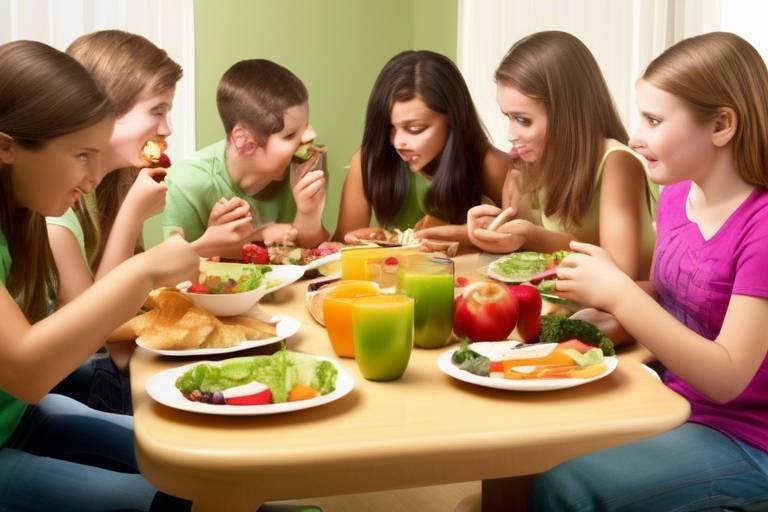Nurturing Healthy Eating Habits in Toddlers: A Guide for Parents
As parents, we all want the best for our little ones, and that includes nurturing healthy eating habits from the very beginning. But let’s be honest, getting toddlers to eat a balanced diet can sometimes feel like trying to herd cats! The good news is that there are effective strategies you can employ to make this journey smoother and more enjoyable for both you and your child. By focusing on creating a positive relationship with food, you can help your toddler develop a love for nutritious options that will last a lifetime.
Understanding the critical role of nutrition in a toddler's growth and development is essential for making informed choices about their diet. During these formative years, toddlers are not just growing physically; their brains are also developing rapidly. A well-balanced diet rich in vitamins, minerals, and other nutrients supports cognitive function and overall health. Think of nutrition as the fuel that powers your toddler’s adventures, from exploring the backyard to mastering the art of building block towers!
A well-structured meal plan can introduce variety and balance to a toddler's diet, ensuring they receive essential nutrients while developing healthy eating patterns. But what does a balanced meal plan look like? It’s all about variety! Incorporating a mix of proteins, grains, fruits, and vegetables can make meals exciting and nutritious. For instance, you might consider a weekly meal plan that includes:
| Day | Breakfast | Lunch | Dinner |
|---|---|---|---|
| Monday | Oatmeal with berries | Turkey and cheese sandwich | Grilled chicken with broccoli |
| Tuesday | Scrambled eggs and toast | Vegetable soup | Fish sticks with peas |
| Wednesday | Pancakes with banana | Quinoa salad | Beef stir-fry with rice |
Fruits and vegetables are vital for toddlers' health, yet getting them to eat these often can be a challenge. The key is to discover creative ways to incorporate these foods into meals and snacks that appeal to young taste buds. For example, you can turn a simple fruit salad into a colorful masterpiece by adding a variety of fruits and letting your toddler help with the assembly. Or how about sneaking some spinach into a smoothie? They won’t even know it’s there!
Engaging toddlers with fun presentations of fruits and vegetables can encourage them to try new foods and develop a love for healthy options. Consider using cookie cutters to create fun shapes or arranging food into smiley faces on their plates. The more visually appealing the meal, the more likely your toddler is to dive in!
Using seasonal produce not only enhances flavor but also introduces toddlers to a variety of textures and colors, making meals more exciting and nutritious. Seasonal fruits and veggies are often fresher and more affordable, so why not take a trip to a local farmer’s market? It can be a fun family outing and a great way to teach your child about where their food comes from.
Teaching toddlers about appropriate portion sizes is essential for developing self-regulation skills and preventing overeating. It’s easy for little ones to get overwhelmed by a full plate, so starting with smaller portions can be a great strategy. You can always offer seconds if they’re still hungry! This approach fosters a healthy relationship with food, allowing them to listen to their bodies and eat until they are satisfied.
Creating a positive mealtime atmosphere can significantly influence a toddler's willingness to try new foods and enjoy the eating experience. Think of mealtime as a special family gathering, where everyone is encouraged to share and connect. Setting the table nicely, turning off screens, and engaging in pleasant conversation can transform a mundane meal into a delightful occasion.
Reducing distractions during mealtime can help toddlers focus on their food and develop mindful eating habits, which are crucial for long-term health. Try to make mealtime a screen-free zone and encourage your toddler to engage in conversation about their day. This not only makes them feel valued but also encourages them to enjoy their food more.
Engaging toddlers in meal preparation can spark their interest in food and encourage them to try new dishes. Simple tasks like washing vegetables, stirring ingredients, or setting the table can make your little one feel like a chef in the kitchen. This involvement can lead to a greater willingness to taste the meals they helped create, making healthy eating a fun family activity.
- How can I get my toddler to eat more vegetables?
Try incorporating vegetables into their favorite dishes, using fun presentations, and involving them in meal prep. - What if my toddler refuses to eat certain foods?
Keep offering those foods without pressure, as it may take multiple exposures for them to accept it. - Is it okay for my toddler to snack between meals?
Yes, healthy snacks can be beneficial, but aim for nutritious options like fruits, vegetables, or yogurt.

The Importance of Early Nutrition
Understanding the critical role of nutrition in a toddler's growth and development can help parents make informed choices about their child's diet and eating habits. During these formative years, a toddler's brain is developing at an astonishing rate, and the right nutrients are essential for cognitive function, physical growth, and emotional well-being. Imagine a tiny seed sprouting into a strong, healthy plant; the quality of the soil and sunlight it receives directly impacts its growth. Similarly, the food we provide our toddlers lays the foundation for their future health.
Nutrition in early childhood is not just about filling their bellies; it’s about nurturing their potential. A balanced diet rich in vitamins, minerals, and essential fatty acids can lead to better concentration, improved mood, and a lower risk of chronic diseases later in life. For instance, foods high in omega-3 fatty acids, like fish and flaxseeds, are known to support brain development. Parents often wonder, "What should I be feeding my little one?" The answer lies in variety. A colorful plate is often a sign of a nutritious meal.
To illustrate the significance of early nutrition, consider the following table that outlines key nutrients and their benefits:
| Nutrient | Benefits |
|---|---|
| Calcium | Essential for bone growth and development. |
| Iron | Crucial for cognitive development and preventing anemia. |
| Vitamin A | Supports vision and immune function. |
| Vitamin C | Boosts the immune system and aids in iron absorption. |
Additionally, establishing healthy eating habits early on can set the stage for a lifetime of good nutrition. Toddlers are naturally curious and often willing to try new foods, especially when they see their parents enjoying them. It’s like planting seeds of curiosity that will blossom into lifelong preferences for healthy foods. Parents can encourage this by modeling healthy eating behaviors and making mealtime a positive experience. Remember, toddlers may need to be exposed to a new food several times before they accept it. So, patience is key!
In conclusion, early nutrition is a cornerstone of healthy development. By prioritizing a balanced diet filled with essential nutrients, parents can help their toddlers thrive physically and mentally. The journey of nurturing healthy eating habits begins at home, and the choices made today will pave the way for a healthier tomorrow.
- What are some easy ways to introduce new foods to toddlers? Start by offering small portions alongside familiar favorites and encourage them to explore different textures and flavors.
- How can I ensure my toddler is getting enough nutrients? Focus on a variety of foods from all food groups, including fruits, vegetables, whole grains, and proteins.
- What should I do if my toddler refuses to eat vegetables? Try different cooking methods, such as roasting or blending them into smoothies, and make them fun by creating colorful plates.

Creating a Balanced Meal Plan
Creating a balanced meal plan for toddlers is not just about filling their plates; it's about laying the groundwork for a lifetime of healthy eating habits. Think of it as building a sturdy house—without a solid foundation, everything else can crumble. A well-structured meal plan introduces variety and balance to a toddler's diet, ensuring they receive essential nutrients while developing healthy eating patterns. So, how do you create this perfect meal plan? Let's dive into the essentials!
First and foremost, it's crucial to include a mix of food groups in every meal. The ideal toddler plate should contain:
- Fruits and Vegetables: Aim for a rainbow of colors! Different colors often mean different nutrients.
- Whole Grains: Foods like brown rice, whole grain bread, and oatmeal provide energy and fiber.
- Proteins: Incorporate lean meats, legumes, and dairy to support growth and development.
- Healthy Fats: Foods like avocados, nuts, and olive oil are essential for brain development.
Now, you might be wondering, "How do I ensure my toddler is actually eating these foods?" One effective strategy is to create a weekly meal plan. This not only helps you stay organized but also allows your toddler to anticipate what’s coming next, making them more likely to try new foods. You could even let them help choose meals from a selection of healthy options, giving them a sense of control and involvement.
To make things even more engaging, consider using a visual chart that outlines the meals for each day. A simple table can help your child understand what to expect:
| Day | Breakfast | Lunch | Dinner |
|---|---|---|---|
| Monday | Oatmeal with berries | Turkey and cheese sandwich with carrot sticks | Grilled chicken, quinoa, and steamed broccoli |
| Tuesday | Scrambled eggs with spinach | Vegetable soup with whole grain crackers | Fish tacos with avocado and salsa |
| Wednesday | Yogurt with sliced bananas | Hummus and pita with cucumber slices | Pasta with marinara and mixed veggies |
| Thursday | Whole grain pancakes with fruit | Chicken salad with mixed greens | Stuffed bell peppers with brown rice |
| Friday | Smoothie with spinach and mango | Quinoa bowl with black beans | Homemade pizza with assorted toppings |
In addition to meal planning, it's important to keep portions in check. Toddlers have small stomachs, so serving sizes should be appropriate for their age. A good rule of thumb is to offer them a tablespoon of each food for every year of their age. This way, they can learn to listen to their hunger cues and develop self-regulation skills.
Lastly, remember that flexibility is key! While having a plan is fantastic, it's equally important to be adaptable. Some days your toddler might be more adventurous than others, and that’s perfectly okay. The goal is to create a positive relationship with food, where trying new things feels exciting rather than daunting. So, embrace the messiness of mealtime, and celebrate each little victory along the way!

Incorporating Fruits and Vegetables
When it comes to into your toddler's diet, creativity is key! Toddlers are naturally curious and often drawn to bright colors and fun shapes, so why not use this to your advantage? One effective strategy is to make these healthy foods visually appealing. For instance, you can create a rainbow plate that includes a variety of fruits and vegetables, showcasing their vibrant colors. This not only makes the meal more enticing but also introduces your little one to a range of nutrients.
Another great way to encourage your toddler to eat more fruits and vegetables is by turning them into snacks. Think about fruit kabobs or vegetable sticks paired with a tasty dip. You can use items like hummus, yogurt, or even a homemade guacamole to make the experience more enjoyable. When toddlers are given the opportunity to dip their food, they often become more adventurous eaters. Plus, it adds an element of fun to their meals!
Moreover, consider involving your toddler in the process of selecting fruits and vegetables at the grocery store or local farmer's market. Allowing them to pick out items that catch their eye can create a sense of ownership and excitement about eating these foods. You might be surprised at what they choose! For instance, they may opt for a quirky-looking vegetable they've never tried before, leading to a new culinary adventure at home.
It's also important to introduce fruits and vegetables in various forms. While fresh produce is fantastic, don't overlook other options like frozen, canned, or dried fruits and vegetables. These can be just as nutritious and sometimes more convenient, especially when you're in a pinch. Just be sure to check for added sugars or preservatives when choosing canned options. Here’s a quick breakdown:
| Form | Benefits |
|---|---|
| Fresh | Highest in nutrients; great for salads and snacks. |
| Frozen | Picked at peak ripeness; convenient and retains nutrients. |
| Canned | Long shelf life; good for soups and stews, but check for added sugars. |
| Dried | Portable and great for on-the-go snacks; watch for added sugars. |
Lastly, don't forget about the power of smoothies! Blending fruits and vegetables into a smoothie can be a sneaky way to pack in nutrients. You can add spinach or kale along with bananas, berries, and yogurt for a delicious treat that your toddler will love. Just remember to keep the flavors balanced; too much spinach might turn them off, so start with small amounts and gradually increase as they get used to it.
In summary, incorporating fruits and vegetables into your toddler's diet doesn't have to be a chore. With a little creativity and involvement, you can turn it into a fun and engaging experience. Remember, the goal is to create a positive relationship with food that lasts a lifetime!
- How can I encourage my toddler to try new fruits and vegetables? Try involving them in the selection process and presenting the food in fun, creative ways.
- What are some good snacks that include fruits and vegetables? Fruit kabobs, veggie sticks with dip, and smoothies are excellent options!
- Is it okay to serve canned fruits and vegetables? Yes, just be sure to choose options without added sugars or preservatives.

Fun Presentation Ideas
When it comes to toddlers, the way food is presented can make all the difference. Imagine a plate filled with vibrant colors and fun shapes; it’s like a party on a platter! Engaging your little ones with creative food presentations can spark their interest and encourage them to try new foods. So, how can you make mealtime more exciting? Here are some fun ideas to get you started:
First off, consider using cookie cutters to create fun shapes from fruits and vegetables. For instance, a simple cucumber slice can transform into a star or heart shape, making it more appealing to tiny hands. You can also arrange fruits into a rainbow pattern on their plates. Not only does this look delightful, but it’s also a great opportunity to teach your toddler about colors!
Another fantastic idea is to create “food art.” Use various ingredients to make fun characters or scenes. For example, a pancake can become a face with banana slices for eyes and a blueberry for a nose. This not only makes the meal visually appealing but also turns eating into a creative activity. You might find that your toddler is more willing to try new foods when they’re part of a fun and imaginative scene!
Additionally, consider using themed meals to keep things fresh and exciting. For instance, you could have a “taco night” where everyone builds their own tacos. Set out a variety of colorful toppings like shredded carrots, diced tomatoes, and shredded cheese, allowing your toddler to choose what they want to add. This not only empowers them to make choices but also encourages them to taste new ingredients in a fun way.
Lastly, remember that the utensils and dishes you use can also play a role in presentation. Brightly colored plates, fun-shaped bowls, or even using small cups for dips can make the dining experience more enjoyable. You might even consider introducing chopsticks or fun straws to add an element of playfulness to the meal.
In summary, making food fun and visually appealing is a powerful tool in encouraging toddlers to embrace healthy eating habits. By incorporating playful presentations, you can turn each meal into an adventure, making it easier for your little ones to develop a positive relationship with food.
1. How can I encourage my toddler to eat more vegetables?
Incorporating vegetables into fun dishes, like smoothies or veggie dips, can make them more appealing. Presenting them in creative shapes or as part of a fun meal theme can also spark interest.
2. What are some healthy snack ideas for toddlers?
Healthy snacks can include fruit kabobs, yogurt with berries, or whole-grain crackers with cheese. The key is to make them colorful and fun to eat!
3. How can I make mealtime less stressful?
Creating a calm and distraction-free environment can help. Involve your toddler in the meal preparation process, and turn off screens to encourage focused eating.
4. Should I force my toddler to try new foods?
It’s best to avoid forcing them. Instead, offer new foods alongside familiar favorites, and encourage them to taste without pressure. This way, they can explore at their own pace.

Seasonal Produce Benefits
When it comes to nurturing healthy eating habits in toddlers, one of the most delightful ways to do so is by incorporating seasonal produce into their meals. Why, you ask? Well, seasonal fruits and vegetables are not just fresher and tastier; they also pack a nutritional punch that can significantly benefit your little ones. Imagine biting into a juicy strawberry in the summer or savoring a warm butternut squash in the fall—these flavors are enhanced when the produce is at its peak. Not only do seasonal foods taste better, but they also offer a variety of essential nutrients that support your toddler's growth and development.
In addition to flavor and nutrition, seasonal produce can introduce your child to an array of textures and colors. This diversity not only makes meals visually appealing but also encourages toddlers to explore different foods. When children see a rainbow of fruits and vegetables on their plates, they are more likely to be curious and willing to try something new. For instance, incorporating vibrant vegetables like purple carrots or yellow squash can turn an ordinary meal into a colorful feast that sparks interest and excitement.
Moreover, using seasonal produce can also be a fun way for parents to teach their toddlers about the importance of sustainability and supporting local farmers. By choosing fruits and vegetables that are in season, you’re not only providing your child with the best quality food but also reducing the carbon footprint associated with transporting out-of-season produce. It's a win-win! To illustrate the benefits of seasonal eating, here’s a quick comparison of seasonal produce:
| Season | Fruits | Vegetables |
|---|---|---|
| Spring | Strawberries, Cherries | Asparagus, Spinach |
| Summer | Peaches, Watermelon | Tomatoes, Zucchini |
| Fall | Apples, Pears | Butternut Squash, Broccoli |
| Winter | Citrus Fruits, Pomegranates | Carrots, Kale |
By focusing on seasonal produce, you can also create a teaching moment for your toddler. Why not take a trip to a local farmers' market? Let them pick out their favorite fruits and vegetables, and talk about where they come from. This not only builds a connection to food but also encourages them to appreciate the hard work that goes into growing it. So, the next time you plan your meals, consider the benefits of seasonal produce. It’s a simple yet effective way to foster a lifelong love for healthy eating!
Q: How can I tell which fruits and vegetables are in season?
A: You can check local farmers' market schedules, seasonal produce guides online, or even ask at your grocery store. Many stores label seasonal items.
Q: Are seasonal foods more expensive?
A: Not necessarily! Seasonal produce is often more abundant, which can lead to lower prices. Plus, buying local can save you money.
Q: How can I get my toddler to try seasonal fruits and vegetables?
A: Make it fun! Involve them in picking out produce, and try creative presentations or fun recipes to entice them to taste.

Understanding Portion Sizes
When it comes to toddlers, understanding portion sizes is more than just a numbers game; it's a vital skill that lays the foundation for a healthy relationship with food. Imagine teaching your little one to listen to their body's cues, recognizing when they're hungry and when they're full. This is where the magic of portion sizes comes into play. By introducing appropriate portions, parents can help toddlers develop self-regulation skills that are crucial for lifelong healthy eating habits.
But how do you determine what a proper portion looks like for a toddler? It's not as daunting as it sounds! In fact, many experts suggest using simple guidelines based on the child's age and developmental stage. For instance, a toddler's portion size can often be about one-quarter of an adult portion. This means if you're serving spaghetti, a toddler might enjoy a serving of around 1/4 to 1/2 cup, depending on their appetite that day.
To make it even easier for parents, here’s a handy reference guide for common food groups:
| Food Group | Recommended Portion Size for Toddlers |
|---|---|
| Fruits | 1/4 to 1/2 cup (e.g., sliced banana, berries) |
| Vegetables | 1/4 to 1/2 cup (e.g., steamed carrots, peas) |
| Grains | 1/4 to 1/2 cup (e.g., cooked rice, pasta) |
| Protein | 1 ounce (e.g., chicken, fish, beans) |
| Dairy | 1/2 cup (e.g., yogurt, milk) |
It's essential to remember that toddlers have fluctuating appetites. Some days they may devour everything in sight, while on others, they may barely touch their food. This variability is completely normal and should be embraced. As parents, the goal is to offer a variety of healthy options without pressure. Allowing toddlers to decide how much to eat from the portions provided can empower them and foster independence.
Furthermore, using visual cues can make portion sizes more relatable for young children. For example, you might use everyday items, like a tennis ball to represent a serving of fruit or a deck of cards to illustrate a portion of protein. These analogies can help toddlers grasp the concept of portion sizes in a fun and engaging way.
In conclusion, understanding and teaching portion sizes is not just about controlling how much food a toddler eats; it’s about helping them cultivate a healthy relationship with food that will last a lifetime. By incorporating appropriate portions, parents can guide their children toward becoming mindful eaters, ultimately leading to healthier choices as they grow.

Encouraging Positive Eating Environments
Creating a positive eating environment is like setting the stage for a delightful performance; it can significantly influence a toddler's willingness to explore new foods and enjoy mealtime. When toddlers feel comfortable and excited during meals, they are more likely to try new foods and develop a healthy relationship with eating. So, how can parents cultivate this nurturing atmosphere? Here are some effective strategies to consider.
First and foremost, it's essential to establish a consistent mealtime routine. Just like bedtime rituals help toddlers feel secure, a regular eating schedule can create a sense of stability. Aim for three meals and two healthy snacks each day, served around the same times. This predictability helps toddlers anticipate mealtimes and can even boost their appetite. Think of it as laying down the tracks for a train; once the routine is established, the journey becomes smoother.
Another key aspect is to minimize distractions during meals. In our fast-paced world filled with screens and noise, it can be tempting to turn on the TV or scroll through phones while eating. However, this can divert a toddler's attention away from their food, making it harder for them to focus on what’s in front of them. Instead, create a calm and inviting atmosphere by turning off electronic devices and engaging in conversation. This not only encourages mindful eating but also fosters family bonding. After all, mealtime is a perfect opportunity to connect and share stories!
Furthermore, involving toddlers in meal preparation can transform mealtime into a fun family activity. When children participate in cooking, they gain a sense of ownership and pride over their meals. They might be more inclined to taste what they've helped create. Simple tasks like washing vegetables, stirring, or arranging food on plates can make them feel like little chefs. It’s a hands-on approach that not only teaches them about food but also makes healthy eating an exciting adventure.
Lastly, consider the presentation of food. Just like a beautifully wrapped gift is more enticing to open, a colorful and creatively arranged plate can spark a toddler's interest. Use vibrant fruits and vegetables to create fun shapes or designs on their plates. For example, you could make a smiley face out of sliced bananas and blueberries or arrange carrot sticks to resemble a rainbow. Such playful presentations can make healthy foods more appealing and encourage toddlers to try new flavors without any fuss.
In summary, nurturing a positive eating environment involves setting a routine, minimizing distractions, involving toddlers in meal prep, and presenting food in fun ways. By creating this supportive atmosphere, parents can help their toddlers develop a lifelong love for healthy eating. Remember, the goal is not just to fill their tummies but to cultivate a joyful relationship with food that lasts a lifetime!
- What are some tips for dealing with picky eaters? Encourage exploration by offering a variety of foods without pressure. Make mealtime fun and involve them in choosing and preparing meals.
- How can I ensure my toddler gets enough nutrients? Focus on a colorful plate filled with fruits, vegetables, whole grains, and protein sources. A diverse diet helps meet their nutritional needs.
- Is it okay to let toddlers snack between meals? Yes! Healthy snacks can help maintain energy levels. Just ensure they are nutritious options like fruits, vegetables, or yogurt.

Minimizing Distractions
When it comes to mealtime, creating the right atmosphere is essential for toddlers to focus on their food. Imagine trying to read a book in a loud, crowded café; it’s nearly impossible to absorb any information, right? The same principle applies to toddlers at the dinner table. Distractions can significantly hinder their ability to engage with their meals and understand the flavors they are experiencing. So, how can parents cultivate a distraction-free environment that encourages healthy eating habits?
First and foremost, consider turning off the television and putting away any electronic devices during mealtime. These gadgets can easily steal a toddler's attention, diverting it away from the food in front of them. Instead, aim for a calm and inviting atmosphere. You might even want to light a candle or play soft music to set the mood. The idea is to create a space where your little one feels relaxed and focused on their meal.
Another effective strategy is to establish a designated eating area. This could be a cozy corner of the dining room or a colorful tablecloth on the kitchen table. When toddlers have a specific place to eat, it helps them associate that space with mealtime, reducing the urge to wander off or get distracted. Plus, a visually appealing setting can make the experience more enjoyable. Consider using fun plates or utensils that reflect their favorite characters or colors, making the dining experience feel special.
In addition to the physical environment, it’s crucial to minimize sensory distractions as well. For instance, if there are loud noises from outside or other family members bustling around, your toddler may find it hard to concentrate on their food. Create a peaceful atmosphere by keeping the volume down and encouraging others to be mindful during mealtime. This not only helps your toddler focus but also fosters a sense of community and togetherness during family meals.
It's also beneficial to lead by example. Children are observant, and they tend to mimic the behavior of adults. If you demonstrate mindful eating—taking your time, savoring each bite, and engaging in conversation—your toddler is likely to follow suit. Share stories about the food you’re eating, its colors, and its textures. This not only keeps them engaged but also cultivates curiosity about different foods, paving the way for a more adventurous palate.
Finally, consistency is key. Establishing a routine around mealtime can help your toddler know what to expect. Try to serve meals at the same time each day, and encourage everyone to sit down together. This not only minimizes distractions but also reinforces the importance of family time and healthy eating habits. Remember, the goal is to create a nurturing environment where your toddler can develop a positive relationship with food, free from unnecessary distractions.
- How can I encourage my toddler to eat a variety of foods?
Involve them in meal preparation, offer a variety of colorful foods, and make mealtime fun with creative presentations.
- What should I do if my toddler refuses to eat?
Stay calm and avoid pressure; instead, offer the food again later and model positive eating behaviors.
- How can I make healthy eating habits stick?
Be consistent, set a routine, and create a positive mealtime atmosphere to encourage healthy choices.

Involving Toddlers in Meal Preparation
Involving toddlers in meal preparation can be a game-changer when it comes to instilling healthy eating habits. Imagine the excitement on their little faces as they help mix, stir, and even choose ingredients! It’s not just about getting a helping hand in the kitchen; it’s about creating a bonding experience that teaches them valuable skills and fosters a love for food. When toddlers participate in cooking, they become more curious about what they are eating, which can lead to a greater willingness to try new foods.
Start with simple tasks that are age-appropriate. For instance, toddlers can help wash vegetables, tear lettuce for salads, or sprinkle toppings on dishes. These small actions make them feel important and involved, turning mealtime into a fun activity rather than a chore. You might even consider creating a mini chef station where they have their own tools and ingredients. This can be as simple as a small cutting board, a plastic knife, and some colorful veggies to chop.
Another effective strategy is to let them choose from a selection of healthy ingredients. For example, present them with a variety of fruits and vegetables and ask them to pick their favorites for a smoothie or a salad. This not only makes them feel empowered but also introduces them to the concept of healthy choices. Plus, when they have a say in what goes into their meals, they’re more likely to eat what they’ve helped to prepare.
Here are a few fun ideas to get started:
- Theme Nights: Have a taco night where they can choose their toppings or a pizza night where they can add their favorite veggies.
- Colorful Creations: Encourage them to create rainbow plates with various fruits and veggies, which can also be a great way to discuss the benefits of each color.
- Storytime Cooking: Turn cooking into a story. For example, you can tell them that they are helping to make a magic potion (smoothie) that gives them superpowers!
Remember that the goal is to make cooking enjoyable, not stressful. Allow for messiness; it’s part of the learning process! The more you involve your toddlers in the kitchen, the more likely they are to develop a positive relationship with food. It’s all about creating memories and teaching them that cooking can be a fun adventure. So roll up your sleeves, put on those aprons, and let the culinary exploration begin!
1. At what age can I start involving my toddler in meal preparation?
Most toddlers can start helping in the kitchen as early as 2 years old. Just ensure that the tasks are safe and age-appropriate.
2. What are some safe kitchen tasks for toddlers?
Toddlers can help with washing fruits and vegetables, tearing lettuce, stirring ingredients, and arranging food on plates.
3. How can I encourage my toddler to try new foods?
Involve them in meal prep, let them choose ingredients, and present foods in fun and colorful ways to spark their curiosity.
4. What if my toddler refuses to eat what we've prepared together?
It's perfectly normal for toddlers to be picky eaters. Keep offering a variety of foods without pressure. Over time, their preferences may change.
Frequently Asked Questions
- What are some tips for introducing new foods to my toddler?
Introducing new foods can be a bit like a treasure hunt! Start by offering small portions of new foods alongside familiar favorites. Make it fun by creating colorful plates or using fun shapes. Remember, it might take several tries before they accept a new food, so be patient and keep offering it without pressure.
- How can I encourage my toddler to eat more fruits and vegetables?
Get creative! You can involve your toddler in meal prep, letting them help wash or arrange fruits and veggies. Present them in fun ways—think fruit kabobs or veggie faces on their plate. You could also try smoothies or dips to make them more appealing. The key is to make it a fun experience!
- What portion sizes should I serve my toddler?
Portion sizes for toddlers can be tricky, but a good rule of thumb is to serve about a quarter of an adult portion. Use their hands as a guide: a serving of fruits or veggies should be about the size of their fist. This helps them learn self-regulation and understand when they're full.
- How can I create a positive mealtime environment?
Creating a positive mealtime environment is all about the vibes! Keep the atmosphere relaxed—no screens, no rushing. Engage in light conversation and encourage your toddler to express what they like or dislike about the food. Celebrating small victories, like trying a new food, can make mealtime enjoyable!
- Is it okay to let my toddler snack between meals?
Absolutely! Snacks can be a great way to ensure your toddler gets enough nutrients throughout the day. Just aim for healthy options like fruits, veggies, or whole grains. Keep it balanced and be mindful of portion sizes to avoid spoiling their appetite for meals.
- How can I minimize distractions during mealtime?
Minimizing distractions can be as simple as turning off the TV and putting away toys. Create a designated mealtime space where your toddler knows it’s time to focus on eating. You can even play soft music to set a calming atmosphere, helping them concentrate on their food.
- What are some fun ways to involve my toddler in meal preparation?
Involving your toddler in meal prep can turn cooking into a fun adventure! Let them wash veggies, stir ingredients, or arrange food on the plate. You can even have them pick out fruits and veggies at the store. This hands-on approach can spark their interest in trying new foods!



















